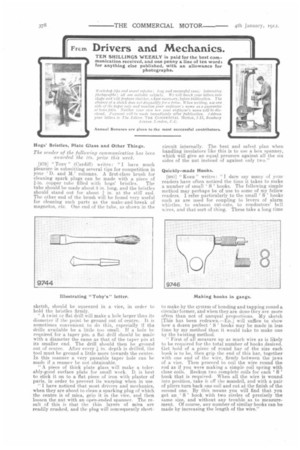Drivers and Mechanics.
Page 20

If you've noticed an error in this article please click here to report it so we can fix it.
TEN SHILLINGS WEEKLY is paid for the best communication received, and one penny a line of ten worth for anything else published, with an allowance for photographs.
Workshop lips and s7nart repairs; long and successful runs; interesting
photographs ; all are suitable subjects. We will hnock your letters into shate and will PrePare sketches, where necesAary, before Publication. The absence of a sketch does not disqualify for a trize. When writing, use one side of the Paper only and mention )our emPloyer's narne as a guarantee of bona fides, Neither your own nor your employer's name will be disclosed. Payment will be made immediately after Publication. A ddress your letters to The Editor, THE CommEnciaL MOTOR, 7-15, Rosebery A re . London, E.C.
Annual Bonuses are given to the most successful contributors.
Hogs' Bristles, Plate Glass and Other Things.
The sender of the following communication. has been awarded the ws. prize this week.
[979] " TOBY " (Cardiff) writes : "I have much pleasure in submitting several tips for competition in
your and M.' columns. A first-class brush for cleaning spark plugs can be made with a piece of
k-in. copper tube filled with hogs' bristles. The tube should be made about 3 in. long, and the bristles should stand out for about 1 in. at the stiff end. The other end of the brush will be found very useful for cleaning such parts as the make-and-break of magnetos, etc. One end of the tube, as shown in the
sketch, should be squeezed in a vice, in order to hold the bristles firmly.
" A twist or flat drill will make a hole larger than its diameter if the point be ground out of centre. It is sometimes convenient to do this, especially if the drills available be a little too small. If a hole be required for a taper pin, a flat drill should be made with a diameter the same as that of the taper pin at its smaller end. The drill should then be ground out of centre. After every I in. depth is drilled, the tool must. be ground a little more towards the centre. In this manner a very passable taper hole can be made if a reamer be not obtainable.
"A piece of thick plate glass will make a tolerably-good surface plate for small work. It is best to stick it on to a flat piece of iron with plaster of paris, in order to prevent its warping when in use. " I have noticed that most drivers and mechanics, when they are about to clean a sparking plug of which the centre is of mica, grin it in the vice, and then loosen the nut with an open-ended spanner. The result of this is that the thin layers of mica are readily crushed, and the plug will consequently short
circuit internally. The best and safest plan when handling insulators like this is to use a box spanner, which will give an equal pressure against all the six sides of the nut instead of against only two."
Quickly-made Hooks.
[980] " Kam " writes: "I dare say many of your readers have often noticed the time it takes to make a number of small '5' hooks. The following simple method may perhaps be of use to some of my fellow readers. I refer particularly to the small S ' hooks such as are used for coupling to levers of alarm whistles, to exhaust cut-outs, to conductors' bell wires, and that sort of thing. These take a long time
to make by the system of bending and tapping round a circular former, and when they are done they are more often than not of unequal proportions. My sketch [This has been redrawn.—En..] will suffice to show how a dozen perfect '5' hooks may be made in less time by my method than it would take to make one by the twisting method.
" First of all measure up as much wire as is likely to be required for the total number of hooks desired. Get hold of a piece of round bar of the size each hook is to be, then grip the end of this bar, together with one end of the wire, firmly between the jaws of a vice. Then proceed to coil the wire round the rod as if you were making a simple coil spring with close coils, Reckon two complete coils for each S ' hook that is required. When all the wire is wound into position, take it off the mandril, and with a pair of pliers turn back one coil and cut at the finish of the second one. By this means you will find that you get an S ' hook with two circles of precisely the same size, and without any trouble as to measurement. Of course, any number of similar hooks can be made by increasing the length of the wire."






















